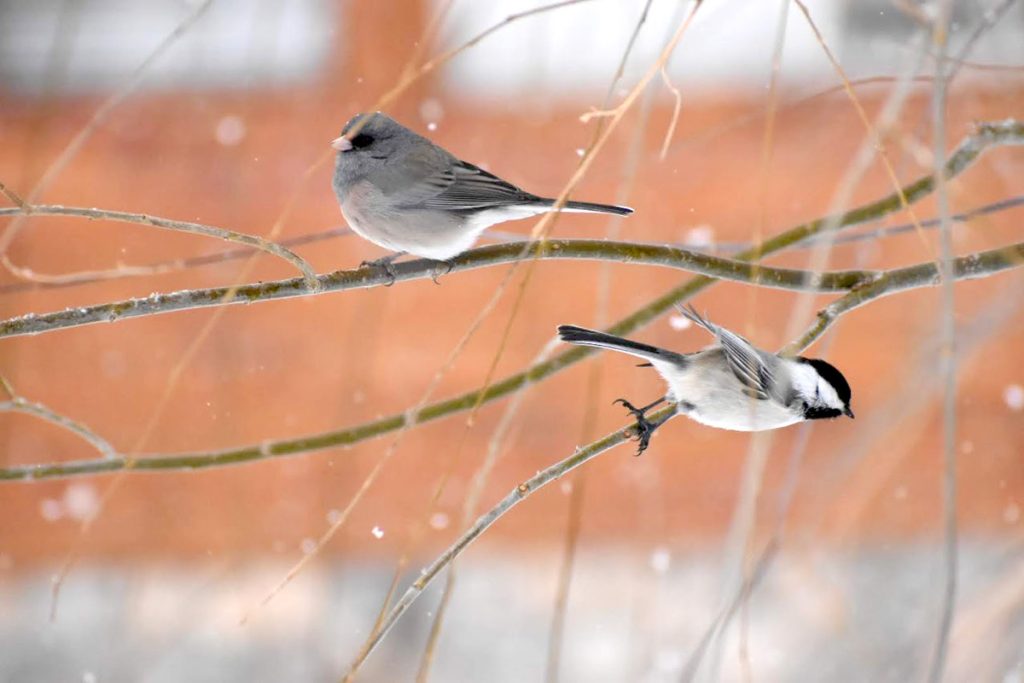
They are the most fearless visitor my bird feeders receive. When other birds fly away in a flock, the humble black-capped chickadee remains, hopping about the branch I attach the feeder to while I refill it, as if impatiently rushing me on. They move in snatches, darting from limb to limb before swooping down and extracting a morsel from the feeder, zipping off to store it somewhere, and then they’re back for more, minutes later. Chickadees aren’t common in New Mexico: their range dips just enough into the northern tip of the state for some lucky denizens of the Enchanted Circle to see them. Their range extends from the western coast of Alaska to the shores of New York, covering much of Appalachia and Canada in between.
Despite their tiny size, no bigger than a child’s fist and weighing less than half an ounce, these are hardy birds that don’t migrate when winter winds begin blowing. Instead, they fluff out their feathers and band together in roost sites with dense vegetation or in crevices. Each winter the birds pack on an additional 10 percent body fat that they burn through on freezing nights, lowering their body temperatures from 107°F to just 53°F. This ability to drastically lower body temperature to conserve energy, called torpor, is a rare adaptation among birds, seen in some species of hummingbirds and the common swift.
This isn’t their only transformation either, as the black-capped chickadee will add brain cells each fall as it prepares to store food for winter, increasing the size of the hippocampus by 30 percent. When spring arrives, these brain cells and their memories are discarded. Their other winter adaptation is simply to not be a picky eater. While they prefer peanutbutter suet, insects, berries, and sunflower seeds, chickadees have no qualms about sharing some carrion with a neighbor crow when resources are scarce. These impressive adaptations don’t mean that chickadees are fine on their own. In fact, a 1988 study by the Ecological Society of America found that chickadees with access to backyard feeders were twice as likely to survive extreme winters (defined as negative night-time temperatures for more than five days).
Deciding who gets to feed first is another matter altogether. Although they’re happy to band together during winter, chickadees maintain a strict dominance hierarchy. Those of higher standing get first choice of feeding position. For example, if one side of a suet feeder is snow-covered, they’ll get the clean side, and if two feeders are present, one with just sunflower seeds and the other with dried fruits and nuts, they’re getting the fancier meal. These hierarchical relationships are embedded into memory and last for years without change. Considering most chickadees live only two to three years (though one male was recorded living for eleven years), these relationships are likely to last a lifetime. Dominance is determined by size, age, and gender. Despite this structure, chickadees work together with a communal alarm system, their iconic “chicka-dee-dee” call. This alerts their roost-mates and any other visitors to feeders that a potential predator is approaching, and the more “-dees” in a call, the more dangerous the threat is. I’ve personally noticed them echoing out their alarm whenever I step outside to fill the feeders, and I’m of the opinion this call can also serve as a sort of dinner bell.
Thankfully, these adorable little birds are not in short supply, as last year’s bird count showed an increase in population. This is likely due to both their exceptional adaptations to harsh temperatures and the large size of breeding clutches, typically six to eight eggs each season. The chickadees form monogamous pairs in late spring (save for a few Casanovas who will breed with multiple females) and build a nest together if they’re unable to find a suitable tree crevice or unused woodpecker nest. The female incubates for about two weeks while the male gathers food and feeds his partner. After another two weeks the young are encouraged to leave the nest and begin their own lives.
Like most birds I’ve written about, science has only begun to scratch the surface of potential applications of chickadees in human life. Their memory was the subject of a talk given by neuroscientist Dmitriy Aronov, Ph.D. at Duke University last March. In his talk he described the “episodic” memory of chickadees, defined as forming memories within a specific context and with exact detail. This, alongside the ability to erase and expand memory, makes the study of chickadee neuroscience fertile ground for unearthing discoveries that could revolutionize the treatment of brain cell loss due to conditions like stroke or Alzheimer’s. Perhaps one day we will say the term “bird-brain” with a totally different meaning.
Author
-

Bryce Flanagan moved from Sacramento, CA to Taos County in 2016, and has lived in Questa for two years. He's passionate about the unique and beautiful wildlife of our state and is a regular contributor to the Questa Del Rio News.
View all posts


